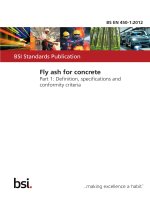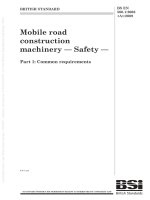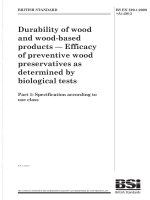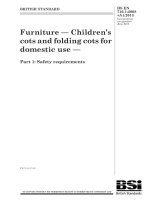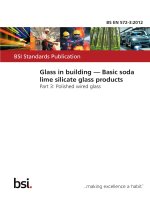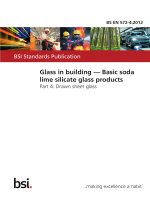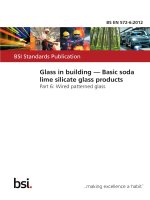Bsi bs en 00572 1 2012 + a1 2016
Bạn đang xem bản rút gọn của tài liệu. Xem và tải ngay bản đầy đủ của tài liệu tại đây (1.36 MB, 18 trang )
BS EN 572-1:2012+A1:2016
BSI Standards Publication
Glass in building — Basic
soda‑lime silicate glass products
Part 1: Definitions and general physical and
mechanical properties
BS EN 572-1:2012+A1:2016
BRITISH STANDARD
National foreword
This British Standard is the UK implementation of
EN 572-1:2012+A1:2016. It supersedes BS EN 572-1:2012 which
is withdrawn.
The start and finish of text introduced or altered by amendment is
indicated in the text by tags. Tags indicating changes to CEN text carry
the number of the CEN amendment. For example, text altered by
CEN amendment A1 is indicated by .
The UK participation in its preparation was entrusted by Technical
Committee B/520, Glass and glazing in building, to Subcommittee
B/520/1, Basic and transformed glass products.
A list of organizations represented on this committee can be obtained
on request to its secretary.
This publication does not purport to include all the necessary provisions
of a contract. Users are responsible for its correct application.
© The British Standards Institution 2016.
Published by BSI Standards Limited 2016
ISBN 978 0 580 89954 6
ICS 81.040.20
Compliance with a British Standard cannot confer immunity from
legal obligations.
This British Standard was published under the authority of the Standards
Policy and Strategy Committee on 31 July 2012.
Amendments/corrigenda issued since publication
Date
Text affected
29 February 2016
Implementation of CEN amendment A1:2016
EN 572-1:2012+A1
EUROPEAN STANDARD
NORME EUROPÉENNE
EUROPÄISCHE NORM
February 2016
ICS 01.040.81; 81.040.20
Supersedes EN 572-1:2012
English Version
Glass in building - Basic soda-lime silicate glass products Part 1: Definitions and general physical and mechanical
properties
Verre dans la construction - Produits de base : verre de
silicate sodo-calcique - Partie 1 : Définitions et
propriétés physiques et mécaniques générales
Glas im Bauwesen - Basiserzeugnisse aus KalkNatronsilicatglas - Teil 1: Definitionen und allgemeine
physikalische und mechanische Eigenschaften
This European Standard was approved by CEN on 11 May 2012 and includes Amendment 1 approved by CEN on 22 November
2015.
CEN members are bound to comply with the CEN/CENELEC Internal Regulations which stipulate the conditions for giving this
European Standard the status of a national standard without any alteration. Up-to-date lists and bibliographical references
concerning such national standards may be obtained on application to the CEN-CENELEC Management Centre or to any CEN
member.
This European Standard exists in three official versions (English, French, German). A version in any other language made by
translation under the responsibility of a CEN member into its own language and notified to the CEN-CENELEC Management
Centre has the same status as the official versions.
CEN members are the national standards bodies of Austria, Belgium, Bulgaria, Croatia, Cyprus, Czech Republic, Denmark, Estonia,
Finland, Former Yugoslav Republic of Macedonia, France, Germany, Greece, Hungary, Iceland, Ireland, Italy, Latvia, Lithuania,
Luxembourg, Malta, Netherlands, Norway, Poland, Portugal, Romania, Slovakia, Slovenia, Spain, Sweden, Switzerland, Turkey and
United Kingdom.
EUROPEAN COMMITTEE FOR STANDARDIZATION
COMITÉ EUROPÉEN DE NORMALISATION
EUROPÄISCHES KOMITEE FÜR NORMUNG
CEN-CENELEC Management Centre: Avenue Marnix 17, B-1000 Brussels
© 2016 CEN
All rights of exploitation in any form and by any means reserved
worldwide for CEN national Members.
Ref. No. EN 572-1:2012+A1:2016 E
BS EN 572-1:2012+A1:2016
EN 572-1:2012+A1:2016 (E)
Contents
Page
European foreword....................................................................................................................................................... 3
1
Scope .................................................................................................................................................................... 5
2
Normative references .................................................................................................................................... 5
3
Terms and definitions ................................................................................................................................... 6
4
General principles........................................................................................................................................... 6
5
5.1
5.2
Chemical composition ................................................................................................................................... 7
General ................................................................................................................................................................ 7
Tint ....................................................................................................................................................................... 7
6
6.1
6.2
6.3
6.3.1
6.3.2
6.3.3
6.4
6.5
6.5.1
6.5.2
Physical and mechanical characteristics ................................................................................................ 7
General characteristics ................................................................................................................................. 7
Characteristic bending strength (fg,kk) ..................................................................................................... 8
Designation of clear glass ............................................................................................................................. 8
General ................................................................................................................................................................ 8
Clear transparent glass ................................................................................................................................. 9
Clear translucent glass .................................................................................................................................. 9
Stability of physical and chemical characteristics ........................................................................... 10
General quality criteria and their evaluation .................................................................................... 10
Optical .............................................................................................................................................................. 10
Appearance..................................................................................................................................................... 11
Annex A !(informative) Complementary information related to REACH" ................................... 12
Bibliography ................................................................................................................................................................. 13
2
BS EN 572-1:2012+A1:2016
EN 572-1:2012+A1:2016 (E)
European foreword
This document (EN 572-1:2012+A1:2016) has been prepared by Technical Committee CEN/TC 129
“Glass in building”, the secretariat of which is held by NBN.
This European Standard shall be given the status of a national standard, either by publication of an
identical text or by endorsement, at the latest by August 2016, and conflicting national standards shall
be withdrawn at the latest by August 2016.
Attention is drawn to the possibility that some of the elements of this document may be the subject of
patent rights. CEN [and/or CENELEC] shall not be held responsible for identifying any or all such patent
rights.
This document includes Amendment 1 approved by CEN on 22 November 2015.
This document supersedes !EN 572-1:2012".
The start and finish of text introduced or altered by amendment is indicated in the text by tags !".
This document has been prepared under a mandate given to CEN by the European Commission and the
European Free Trade Association.
!EN 572-1:2012 was" a revision of EN 572-1:2004. The main changes in this edition !were":
a) a better explanation of the characteristic bending strength of glass;
b) an extension of the minimum light transmittance value for translucent glass up to 19 mm;
c) the bibliography has been complemented.
This European Standard “Glass in building — Basic soda-lime silicate glass products” consists of the
following parts:
— Part 1: Definitions and general physical and mechanical properties;
— Part 2: Float glass;
— Part 3: Polished wired glass;
— Part 4: Drawn sheet glass;
— Part 5: Patterned glass;
— Part 6: Wired patterned glass;
— Part 7: Wired or unwired channel shaped glass;
— Part 8: Supplied and final cut sizes;
— Part 9: Evaluation of conformity/Product standard.
According to the CEN/CENELEC Internal Regulations, the national standards organizations of the
following countries are bound to implement this European Standard: Austria, Belgium, Bulgaria,
3
BS EN 572-1:2012+A1:2016
EN 572-1:2012+A1:2016 (E)
Croatia, Cyprus, Czech Republic, Denmark, Estonia, Finland, Former Yugoslav Republic of Macedonia,
France, Germany, Greece, Hungary, Iceland, Ireland, Italy, Latvia, Lithuania, Luxembourg, Malta,
Netherlands, Norway, Poland, Portugal, Romania, Slovakia, Slovenia, Spain, Sweden, Switzerland,
Turkey and the United Kingdom.
4
BS EN 572-1:2012+A1:2016
EN 572-1:2012+A1:2016 (E)
1 Scope
This Part of this European Standard specifies and classifies basic glass products and indicates their
chemical composition, their main physical and mechanical characteristics and defines their general
quality criteria.
Specific dimensions and dimensional tolerances, description of faults, quality limits and designation for
each basic product type are not included in this Part, but are given in other Parts of EN 572 specific to
each product type:
— EN 572-2
— EN 572-3
— EN 572-4
— EN 572-5
— EN 572-6
— EN 572-7
— EN 572-8
— EN 572-9
Float glass;
Polished wired glass;
Drawn sheet glass;
Patterned glass;
Wired patterned glass;
Wired or unwired channel shaped glass;
Supplied and final cut sizes;
Evaluation of conformity/Product standard.
2 Normative references
The following documents, in whole or in part, are normatively referenced in this document and are
indispensable for its application. For dated references, only the edition cited applies. For undated
references, the latest edition of the referenced document (including any amendments) applies.
EN 410, Glass in building — Determination of luminous and solar characteristics of glazing
EN 572-2, Glass in building — Basic soda lime silicate glass products — Part 2: Float glass
EN 572-3, Glass in building — Basic soda lime silicate glass products — Part 3: Polished wired glass
EN 572-4, Glass in building — Basic soda lime silicate glass products — Part 4: Drawn sheet glass
EN 572-5, Glass in building — Basic soda lime silicate glass products — Part 5: Patterned glass
EN 572-6, Glass in building — Basic soda lime silicate glass products — Part 6: Wired patterned glass
EN 572-7, Glass in building — Basic soda lime silicate glass products — Part 7: Wired or unwired channel
shaped glass
EN 572-8, Glass in building — Basic soda-lime silicate glass products — Part 8: Supplied and final cut sizes
EN 572-9, Glass in building — Basic soda lime silicate glass products — Part 9: Evaluation of
conformity/Product standard
ISO 9385, Glass and glass-ceramics — Knoop hardness test
5
BS EN 572-1:2012+A1:2016
EN 572-1:2012+A1:2016 (E)
3 Terms and definitions
For the purposes of this document, the following terms and definitions apply.
3.1
float
flat, transparent, clear or tinted soda-lime silicate glass having parallel and polished faces obtained by
continuous casting and floatation on a metal bath
Note 1 to entry:
In French called ‘glace’ and in German ‘Floatglas’.
3.2
drawn sheet glass
flat, transparent, clear or tinted soda-lime silicate glass obtained by continuous drawing, initially
vertically, of a regular thickness and with the two surfaces fire polished
Note 1 to entry: Drawn sheet glass covers three products: new antique drawn sheet glass, drawn sheet glass for
renovation and drawn sheet glass with minimum visual faults.
3.3
patterned glass
flat, translucent, clear or tinted soda-lime silicate glass obtained by continuous casting and rolling
3.4
wired patterned glass
flat, translucent, clear or tinted soda-lime silicate glass obtained by continuous casting and rolling
which has a steel mesh welded at all intersections incorporated in the glass during its manufacturing
process
Note 1 to entry:
Note 2 to entry:
The surfaces can be either patterned or plain.
In German, wired patterned glass with plain surfaces is called ‘Drahtglas’.
3.5
polished wired glass
flat, transparent, clear soda-lime silicate glass having parallel and polished faces obtained by grinding
and polishing the faces of wired patterned glass
3.6
wired or unwired channel-shaped glass
translucent, clear or tinted soda-lime silicate glass, wired or unwired, obtained by continuous casting
and rolling, which is formed into a U shape during the manufacturing process
4 General principles
EN 572-1 shall be read in conjunction with Parts 2 to 9 of this European Standard.
6
BS EN 572-1:2012+A1:2016
EN 572-1:2012+A1:2016 (E)
5 Chemical composition
5.1 General
!The basic glass products covered by this European Standard are all manufactured from soda-lime
silicate glass.
The magnitude of the proportions by mass of the principal constituents of soda-lime silicate glass
covered by this European Standard is given in Table 1; see also Annex A:
Table 1 — Magnitude of the proportions by mass of the constituents of soda-lime silicate glass
Constituents
Proportion by mass of element
Silicon (Si)
Calcium (Ca)
Sodium (Na)
Magnesium (Mg)
Aluminium (Al)
Othersa
a
32 % – 35 %
3,5 % – 10,1%
7,4 % – 11,9%
0 % – 3,7%
0 % – 1,6%
< 5%
Properties other than photometric characteristics shall not be significantly altered by these other
components.
"
5.2 Tint
Body tinted glass is obtained by the addition of suitable materials.
6 Physical and mechanical characteristics
6.1 General characteristics
Conventional numerical values for the physical and mechanical characteristics of basic soda-lime
silicate glass products excluding ‘Characteristic bending strength’ (fg,kk) are given in !Table 2".
These values, for normal annealed glass without any further toughening, are not precise requirements
with which the glass shall strictly comply, but are the generally accepted figures for use in calculations
where a high degree of accuracy is not required.
7
BS EN 572-1:2012+A1:2016
EN 572-1:2012+A1:2016 (E)
!Table 2" — General characteristic values of basic soda-lime silicate glass
Characteristic
Symbol
Value and unit
Density (at 18 °C)
ρ
2 500 kg/m3
Young's modulus (modulus of elasticity)
E
Hardness (Knoop)
HK0,1/20
Poisson's ratio
μ
7 × 1010 Pa
cp
α
0,72 × 103 J/(kg ⋅ K)
Resistance against temperature differential and sudden temperature change
Thermal conductivity
λ
40 K b
Mean refractive index to visible radiation (at 589,3 nm)
Emissivity (corrected)
n
ε
1,5
Specific heat capacity
Nominal value of average coefficient of linear expansion between 20 °C and 300 °C
a
b
Knoop Hardness in accordance with ISO 9385.
6 GPa a
0,2
9 × 10-6/K
1 W/(m ⋅ K)
0,837
Generally accepted value that is influenced by edge quality and glass type.
6.2 Characteristic bending strength (fg,kk)
The characteristic bending strength value applies to quasi-static loading over a short time (e.g. wind
loading) and relate to a 5 % probability of breakage at the lower limit of the 95 % confidence interval.
The value of the characteristic bending strength, fg,kk, for soda-lime silicate glass is 45 N/mm².
NOTE
Methods for the determination of the bending strength of glass are given in EN 1288 Parts 1 to 5
(see [1]). Design of glass panes is covered by prEN 13474 (see [6]).
6.3 Designation of clear glass
6.3.1 General
A glass product is designated as clear glass when it is not tinted and when the light transmittance of the
glass material, unmodified by the possible presence of a coating or surface roughness of, for example, a
patterned glass, complies with 6.3.3.
In order to measure the light transmittance characteristics of glass and to determine whether it can be
designated as a clear glass, it is necessary, in some cases, to carry out a pre-treatment such as the
following.
— Coatings on smooth surfaces shall be eliminated, without modifying the thickness of the glass
substrate.
— Rough surfaces, with or without coatings, shall be eliminated by smoothing and polishing. The
thickness of the glass will be modified by this process.
The light transmittance of the glass substrate shall be measured with its surfaces in a polished
condition.
NOTE
The light transmittance values given in 6.3.2 and 6.3.3 are not suitable for design. They are values used
only for the designation of clear glass and exclude the effects of coatings and of surface roughness. The values of
8
BS EN 572-1:2012+A1:2016
EN 572-1:2012+A1:2016 (E)
light transmittance used for design can be obtained from the glass manufacturer. They are determined in
accordance with EN 410.
6.3.2 Clear transparent glass
A transparent glass product shall be designated as clear glass when it is not tinted and when its light
transmittance
— after any necessary pre-treatment,
— measured according to EN 410, and
— rounded to the nearest 0,01,
is greater than or equal to the value given in !Table 3" for the nominal thickness of the glass
product.
NOTE
The limiting value given in !Table 3" is appropriate, provided that the measured thickness of the
glass product is within the allowable tolerances for the nominal thickness of that glass product.
!Table 3" — Minimum light transmittance values for designating a transparent glass
product as clear glass
Nominal thickness in mm
Minimum value of light
transmittance
2
0,89
4
0,87
3
5
6
8
10
12
15
19
25
6.3.3 Clear translucent glass
0,88
0,86
0,85
0,83
0,81
0,79
0,76
0,72
0,67
A translucent glass product shall be designated as clear glass when it is not tinted and when its light
transmittance
— after any necessary pre-treatment,
— measured according to EN 410, and
— rounded to the nearest 0,01,
9
BS EN 572-1:2012+A1:2016
EN 572-1:2012+A1:2016 (E)
is greater than or equal to the value obtained by linear interpolation from !Table 4", for the
measured thickness of the specimen.
NOTE
The limiting value will vary with the exact thickness of the specimen after its pre-treatment.
!Table 4" — Minimum light transmittance values for designating a translucent glass product
as clear glass
Thickness in mm
Minimum value of light
transmittance
3
0,83
5
0,81
4
6
7
8
10
12
14
15
19
6.4 Stability of physical and chemical characteristics
0,82
0,80
0,79
0,78
0,76
0,74
0,72
0,71
0,67
For basic soda-lime silicate glass products, the physical and chemical characteristics can be considered
as remaining constant over time due to the following reasons.
a) Since glass is insensitive to photochemical effects, the spectral properties (transmission of light and
solar energy) of the basic glass products are not modified by direct or indirect solar radiation.
b) The surface of the glass used in building is virtually insensitive to attack from the environment.
NOTE
Whilst the surface of the glass when installed in a building is virtually insensitive to attack from water,
care should be taken to protect the glass surface prior to installation. Inappropriate storage can result in
water/humidity being drawn up between glass sheets. This concentrated environment can cause attack of the
surface (see [7]).
6.5 General quality criteria and their evaluation
6.5.1 Optical
This criterion concerns the visibility of objects observed through the glass and only applies to
transparent glass products.
The main faults that can affect the optical quality are distortion of the surface and lack of homogeneity
in the body of the glass.
The optical quality shall be evaluated by means of a visual observation method.
10
BS EN 572-1:2012+A1:2016
EN 572-1:2012+A1:2016 (E)
6.5.2 Appearance
This criterion concerns the appearance of the product.
The visual quality can be affected by the presence of spot faults (bubbles, stones, etc.), linear/extended
faults (scuff marks, scratches, lines, deposits, impressions, etc.), pattern faults and wire faults.
Spot faults are evaluated by specifying numbers and dimensions.
Linear/extended faults are evaluated by visual observation.
Pattern faults and wire faults are evaluated by measuring deviation.
11
BS EN 572-1:2012+A1:2016
EN 572-1:2012+A1:2016 (E)
Annex A
!(informative)
Complementary information related to REACH
Soda-lime silicate glass is an amorphous inorganic substance obtained from different inorganic raw
materials which react at high temperature to form a new random network, where different elements
are linked together, typically by oxygen bridges, arranged in such a way that no free oxides are present.
Under the REACH Regulation (Registration, Evaluation, Authorisation and Restriction of Chemicals
Regulation (EC) No 1907/2006) glass is considered as a UVCB substance (substance of unknown or
variable composition, complex reaction products or biological materials).
NOTE 1
Soda-lime silicate glass may benefit from exemption from the obligation to register in accordance with
Article 2(7) (b) of REACH (Commission Regulation (EC) No 987/2008).
NOTE 2
Glass products covered by this standard are “articles” in accordance with Article 3(3) of REACH
(Regulation (EC) No 1907/2006).
Soda-lime silicate glass can better be identified by the chemical formula:
NanCaoMgpAlq……SimOs
where
s = n/2 + o + p + 3 q/2 + … + 2 m
12
"
BS EN 572-1:2012+A1:2016
EN 572-1:2012+A1:2016 (E)
Bibliography
[1]
[2]
[3]
[4]
[5]
EN 1288-1, Glass in building — Determination of the bending strength of glass — Part 1:
Fundamentals of testing glass
EN 1288-2, Glass in building — Determination of the bending strength of glass — Part 2: Coaxial
ring test on flat specimens with large test surface areas
EN 1288-3, Glass in building — Determination of the bending strength of glass — Part 3: Test with
specimen supported at two points (four point bending)
EN 1288-4, Glass in building — Determination of the bending strength of glass — Part 4: Testing of
channel shaped glass
EN 1288-5, Glass in building — Determination of the bending strength of glass — Part 5: Coaxial
ring test on flat specimens with small test surface areas
[6]
prEN 13474 (all parts), Glass in building — Design of glass panes — Determination of the load
resistance of glass panes by calculation and testing
[7]
Evaluation of the relevant parameters allowing to prevent the weathering of float glass during
storage, Franco Geotti-Bianchini, Martina Preo, Rivista della Stazione Sperimentale del Vetro n.
3-1999, pages 127 - 146
13
This page deliberately left blank
This page deliberately left blank
NO COPYING WITHOUT BSI PERMISSION EXCEPT AS PERMITTED BY COPYRIGHT LAW
British Standards Institution (BSI)
BSI is the national body responsible for preparing British Standards and other
standards-related publications, information and services.
BSI is incorporated by Royal Charter. British Standards and other standardization
products are published by BSI Standards Limited.
About us
Revisions
We bring together business, industry, government, consumers, innovators
and others to shape their combined experience and expertise into standards
-based solutions.
Our British Standards and other publications are updated by amendment or revision.
The knowledge embodied in our standards has been carefully assembled in
a dependable format and refined through our open consultation process.
Organizations of all sizes and across all sectors choose standards to help
them achieve their goals.
Information on standards
We can provide you with the knowledge that your organization needs
to succeed. Find out more about British Standards by visiting our website at
bsigroup.com/standards or contacting our Customer Services team or
Knowledge Centre.
Buying standards
You can buy and download PDF versions of BSI publications, including British
and adopted European and international standards, through our website at
bsigroup.com/shop, where hard copies can also be purchased.
If you need international and foreign standards from other Standards Development
Organizations, hard copies can be ordered from our Customer Services team.
Subscriptions
Our range of subscription services are designed to make using standards
easier for you. For further information on our subscription products go to
bsigroup.com/subscriptions.
With British Standards Online (BSOL) you’ll have instant access to over 55,000
British and adopted European and international standards from your desktop.
It’s available 24/7 and is refreshed daily so you’ll always be up to date.
You can keep in touch with standards developments and receive substantial
discounts on the purchase price of standards, both in single copy and subscription
format, by becoming a BSI Subscribing Member.
PLUS is an updating service exclusive to BSI Subscribing Members. You will
automatically receive the latest hard copy of your standards when they’re
revised or replaced.
To find out more about becoming a BSI Subscribing Member and the benefits
of membership, please visit bsigroup.com/shop.
With a Multi-User Network Licence (MUNL) you are able to host standards
publications on your intranet. Licences can cover as few or as many users as you
wish. With updates supplied as soon as they’re available, you can be sure your
documentation is current. For further information, email
BSI Group Headquarters
389 Chiswick High Road London W4 4AL UK
We continually improve the quality of our products and services to benefit your
business. If you find an inaccuracy or ambiguity within a British Standard or other
BSI publication please inform the Knowledge Centre.
Copyright
All the data, software and documentation set out in all British Standards and
other BSI publications are the property of and copyrighted by BSI, or some person
or entity that owns copyright in the information used (such as the international
standardization bodies) and has formally licensed such information to BSI for
commercial publication and use. Except as permitted under the Copyright, Designs
and Patents Act 1988 no extract may be reproduced, stored in a retrieval system
or transmitted in any form or by any means – electronic, photocopying, recording
or otherwise – without prior written permission from BSI. Details and advice can
be obtained from the Copyright & Licensing Department.
Useful Contacts:
Customer Services
Tel: +44 845 086 9001
Email (orders):
Email (enquiries):
Subscriptions
Tel: +44 845 086 9001
Email:
Knowledge Centre
Tel: +44 20 8996 7004
Email:
Copyright & Licensing
Tel: +44 20 8996 7070
Email:
